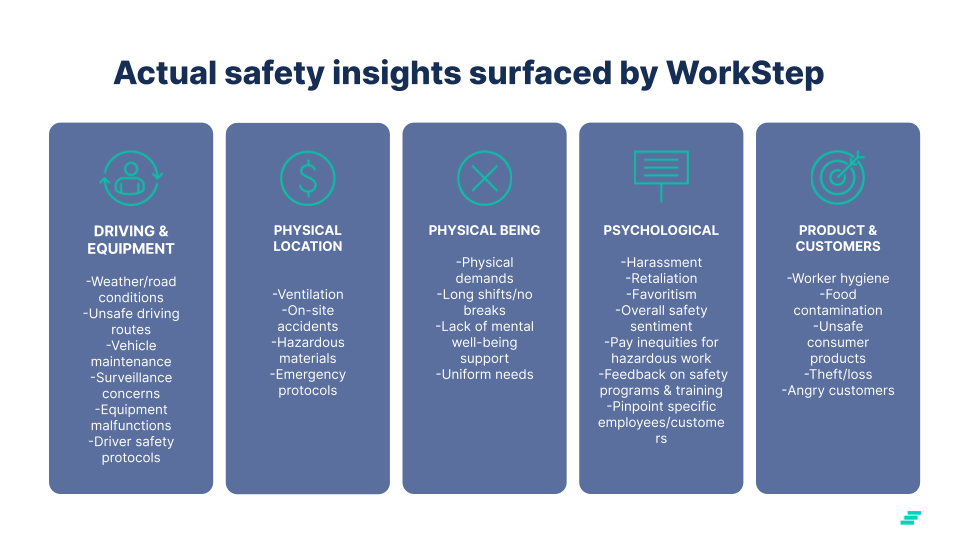Safety has always been a top priority for HR leaders, especially now in a post-Covid world. Employees consider psychological safety and well-being to be just as important as physical safety. So, how can HR leaders create a safer and more inclusive culture? By continuously listening to your employees.
Physical and psychological safety is critical in a frontline environment. Employee listening solutions, like WorkStep, help leaders achieve better workplace outcomes and create a safer and more inclusive culture for their frontline workforce.
Building a business case for workplace safety
Safety has inherent value, but it doesn’t always make its way to the top of the priority list. That’s why it’s important that leaders come up with a strong business case for why workplace safety not only matters but improves the bottom line. Let’s face it, money talks. If a business can demonstrate that the cost of an employee injury or quitting due to unsafe conditions is more than the cost of providing them with a safe environment, a stronger case is made.
Ensuring workplace safety is not merely a moral obligation; it is a strategic imperative for organizations across industries. This is especially true across the supply chain, with transportation and warehouse employees boasting the highest injury and illness rate involving days away from work per 10,000 workers. The numbers speak volumes about the financial and operational impact of safety measures.
In fact, a mid-size warehouse company with an incident rate only 10% above average can expect to pay $100,000 more in premiums per year, and it will take years to go back down!
Average costs can quickly add up. According to statistics from OSHA’s Safety Pays Program the costs of individual injuries include:
- A direct cost of $32,023 and indirect costs of upwards of $35,225 on average for muscle strains.
- A direct cost of $30,487 and indirect costs of upwards of $33,536 on average for sprains.
- A direct cost of $54,856 and indirect costs of upwards of $60,342 on average for fractures.
- A direct cost of $20,940 and indirect costs of upwards of $23,034 on average for hernias.
The Experience Modification Rate, which is determined using three years of safety data, further increases these costs. Organizations with a bad safety track record will feel those costs in employee sentiment and in their budgets.
To put this in perspective, a workplace strain injury can cost upwards of $60,000 after all is said and done, and a mid-size organizational budget for workers’ comp premium can easily top $1,000,000. It’s not just us sounding the alarm either, according to the National Council of Compensation Insurance, between 2021 and 2022 overall workers’ compensation costs increased 20% nationwide in the United States.
That’s a lot of money that would be better spent on additional staff, better equipment, or increased hazard pay!
The financial aspects are only part of the equation. Employees who feel safe in their workplace environment tend to form a stronger emotional connection to their work, leading to improved attendance, loyalty, engagement, and productivity. Supporting this claim, WorkStep data indicates organizations with negative safety sentiment among employees observe nearly three times higher turnover rates at just 30 days post-survey. This turnover not only affects the bottom line but also disrupts operations and erodes morale.
The business case for workplace safety is compelling. It protects a company’s financial health by lowering insurance premium costs while driving higher employee satisfaction. A commitment to safety is not just a legal requirement but a strategic choice that positively impacts an organization’s overall performance and reputation.
Creating a culture of safety for frontline employees
Employee engagement is a critical factor in creating a culture of safety within an organization. It refers to the emotional commitment and involvement of employees towards their work and the organization’s goals. This engagement is not limited to productivity or job satisfaction but extends to the safety and well-being of employees.
In a recent post, Kristen Parisi of HR Brew found that a staggering 58% of frontline employees feel that the risk of physical harm is rising. Furthermore, only 37% of frontline workers feel safe despite 67% of leaders claiming their employees feel safe at work. This is a stark contrast that highlights a major disconnect between the leaders’ perception of safety and the reality.
Engagement is more than just compliance with safety rules; it’s a genuine commitment to look out for one another in the workplace. Our research shows the incidence rates of disengaged employees are 60-64% higher than those of engaged employees. OSHA’s Hazard Identification and Assessment states, “One of the root causes of workplace injuries, illnesses, and incidents is the failure to identify or recognize hazards that are present, or that could have been anticipated.”
The story is clear: engaged employees are more likely to adhere to the safety standards in place and call out safety risks, are better educated on safety best practices, and are more emotionally invested in their roles and coworkers. In essence, employee engagement is the driving force behind a safety-oriented workplace culture that prioritizes the well-being of employees and, in turn, leads to better business outcomes.
Leveraging continuous listening to identify and address critical safety issues
Real-time insights are invaluable when it comes to identifying and addressing safety concerns in the workplace. Continuous feedback allows employees to provide ongoing input about their work environment, enabling organizations to access up-to-date information at will.
Safety is among the top 10% of all topics mentioned by workers within WorkStep surveys and their feedback empowers managers to take swift action on any theme negatively impacting employee sentiment. We have found that utilizing an employee engagement platform, like Workstep, leads to a 9% median increase in general satisfaction after year 1 for all customers.
Continuous feedback goes beyond traditional safety reporting mechanisms. It creates a channel of communication where employees can actively participate in bi-directional conversations, submit unsolicited feedback, and share frequent updates. Managers can quickly scan through employee comments to identify potential issues and conduct further investigation if required.
Real-world examples of safety insights surfaced from WorkStep
At WorkStep, we enable organizations employing a large frontline workforce to manage a continuous listening strategy for their companies. Because of this, we’re able to collect and analyze feedback from tens of thousands of frontline workers in the U.S.
WorkStep helps these organizations identify the need for additional safety information. Below is a long list of safety insights we’ve been able to help surface and address. These insights have proven instrumental in preventing accidents and improving workplace safety for our customers.
WorkStep supports this process through:
- Always-on feedback: Employees can provide continuous feedback about their work environment in real time. This grants managers access to up-to-date information regarding potential safety concerns, facilitating swift action when necessary.
- Comment analysis: Managers can quickly scan employee comments to identify potential safety issues. This tool allows them to pinpoint specific phrases or words indicative of safety problems, prompting further investigation if required.
- Alert system: Managers receive notifications when specific safety criteria are met or exceeded. This ensures prompt identification of potential risk points, enabling swift and appropriate action.
- Action planning tools: Take action informed by key worker insights, including people analytics to track safety metrics, confidential bi-directional communication for quick dissemination of safety requirements, and predictive suggested actions to address specific safety issues.
- Safety program tracking: Track safety initiatives over time to measure the effectiveness of safety initiatives and hold the organization accountable.
- Psychological safety: It is incredibly important that employees feel safe and emotionally connected to their work. Take advantage of question sets to measure loyalty, engagement, and productivity while forming targeted action plans to improve those metrics.
WorkStep is a comprehensive listening platform designed to address and enhance safety in the workplace, particularly for organizations with frontline workers involved in the supply chain. We emphasize the importance of both physical and psychological safety in achieving better business outcomes, including increased productivity and profitability.
Workplace safety is of critical importance, both from a moral and business perspective. It underscores the role of employee engagement in creating a safety-oriented culture, showcasing how engaged employees are more likely to report safety issues, resulting in improved workplace safety and better business outcomes overall.
Tom Goyette, Product Marketing Manager | tom.goyette@workstep.com
Tom Goyette is a Product Marketing Manager at WorkStep. With experience in start-up and enterprise level SaaS and eCommerce organizations, Tom excels at managing and creating content, marketing, and analytics. Tom believes people are at the center of every great organization and is eager to share stories that highlights the value of the employee voice.




